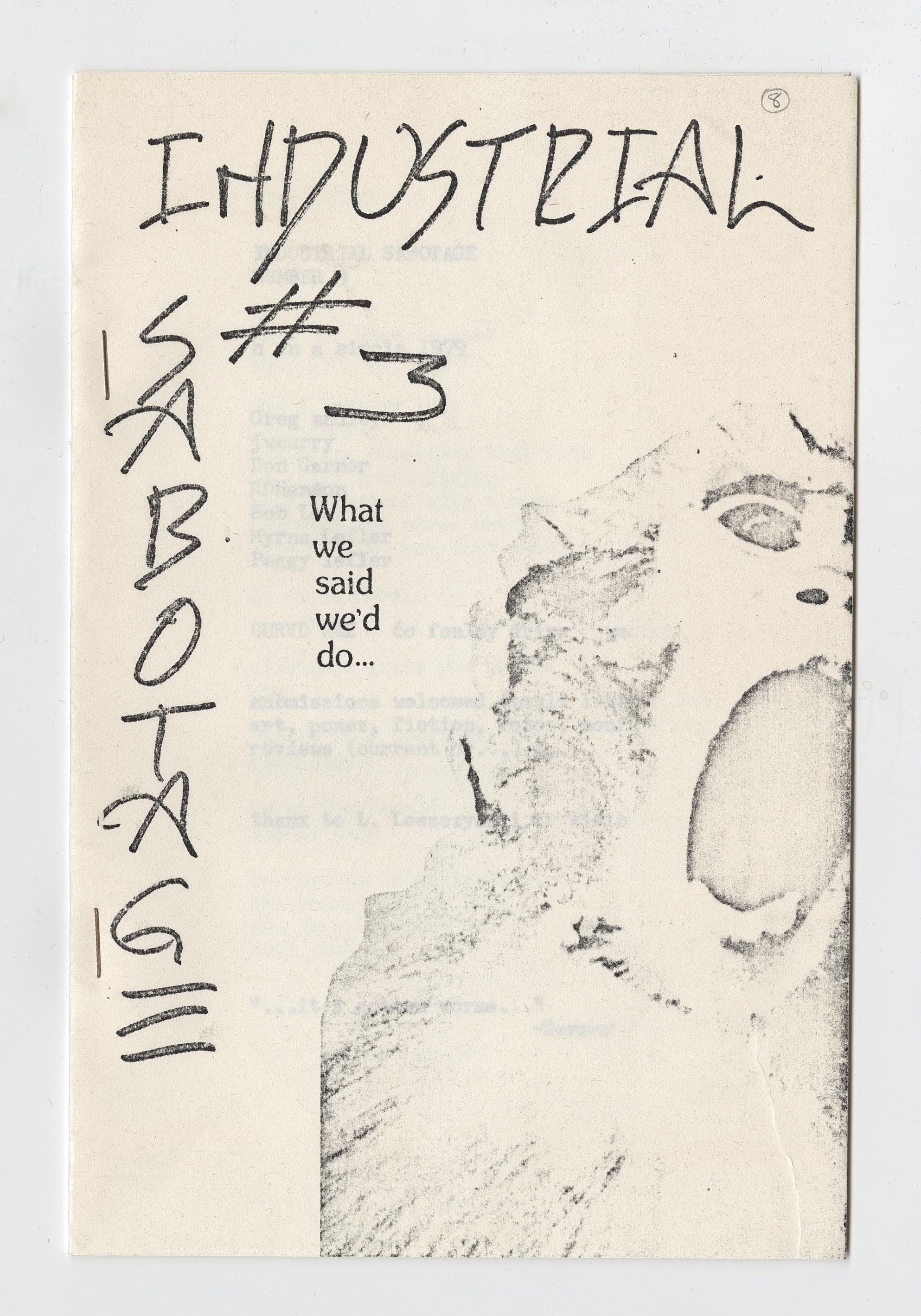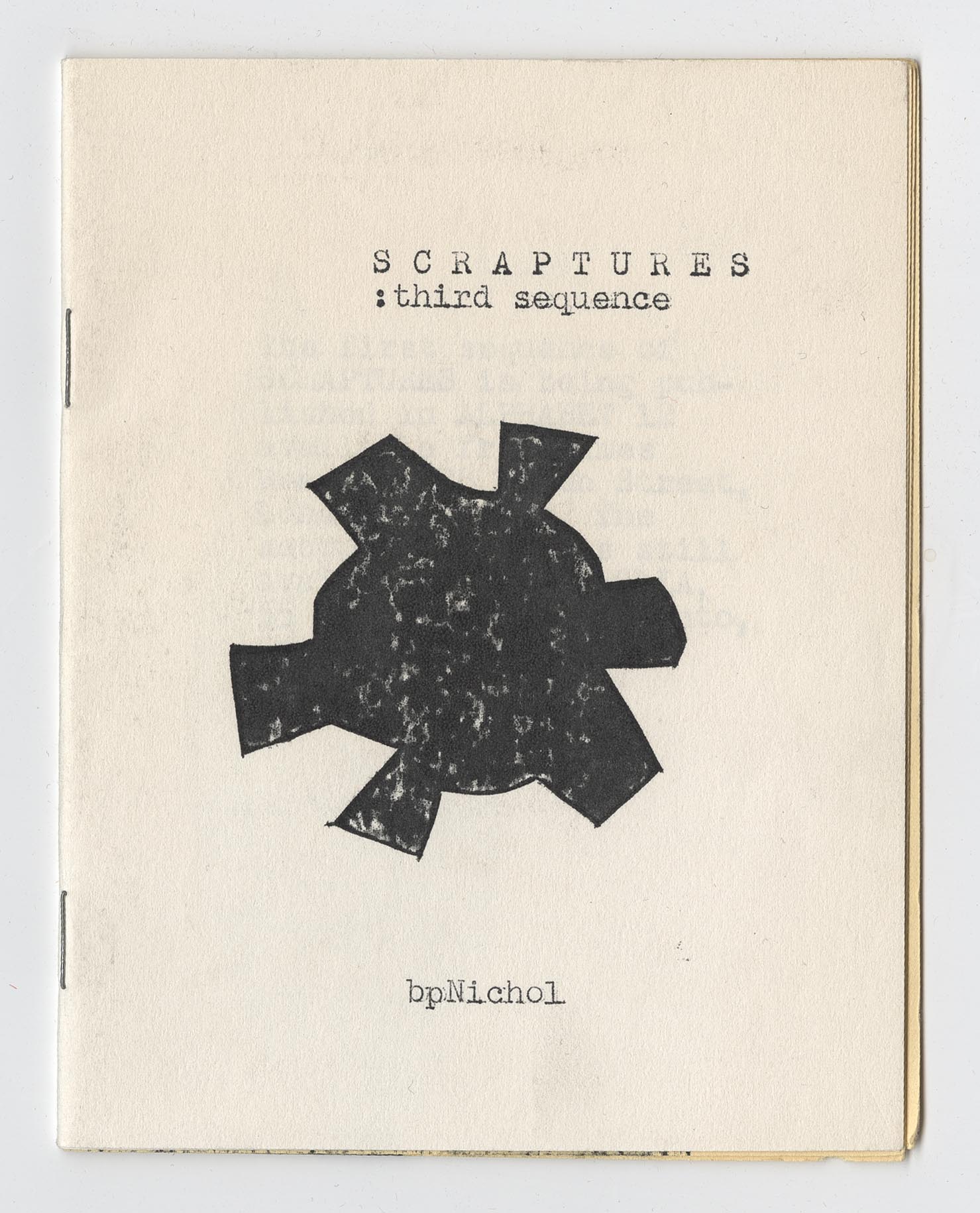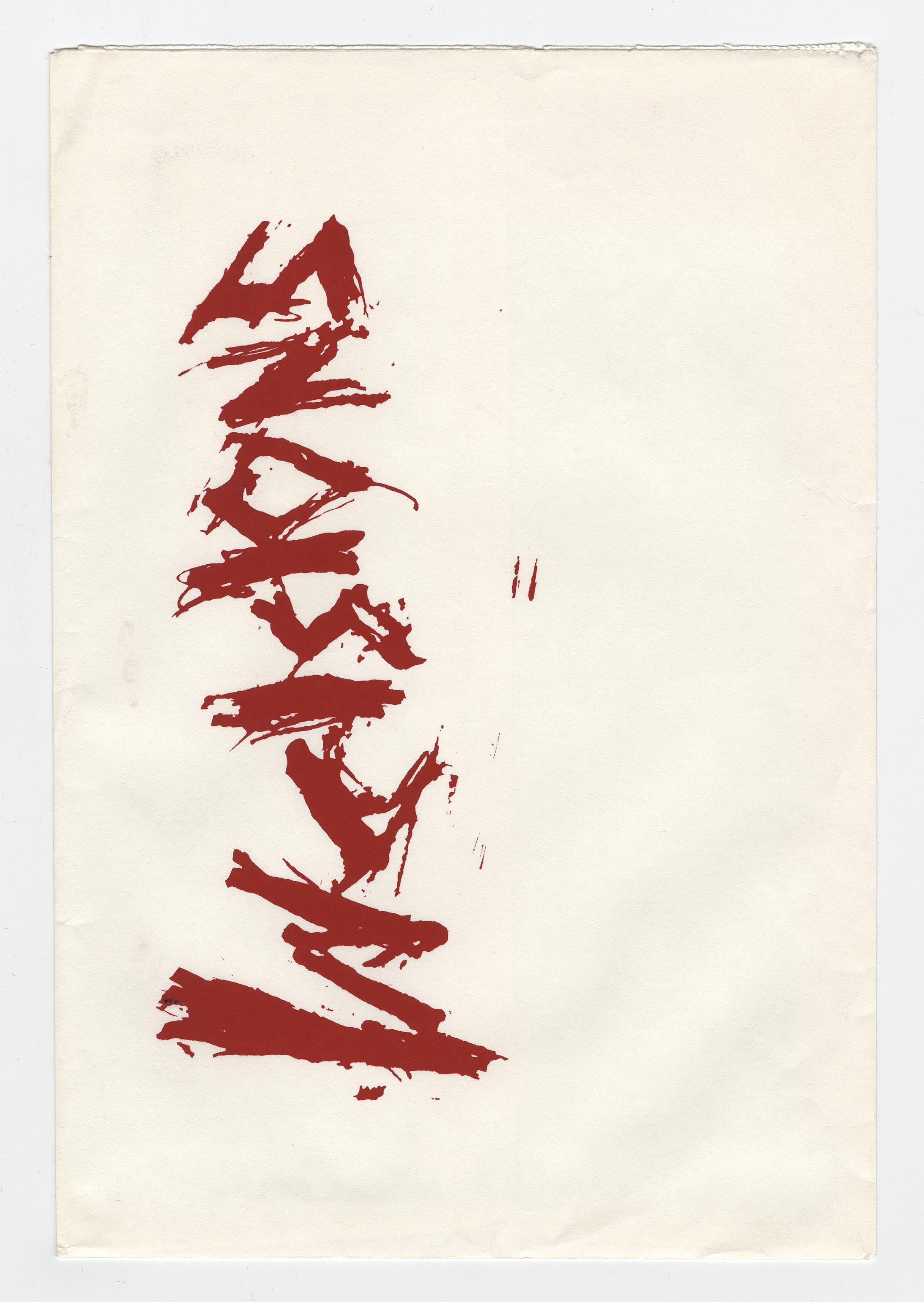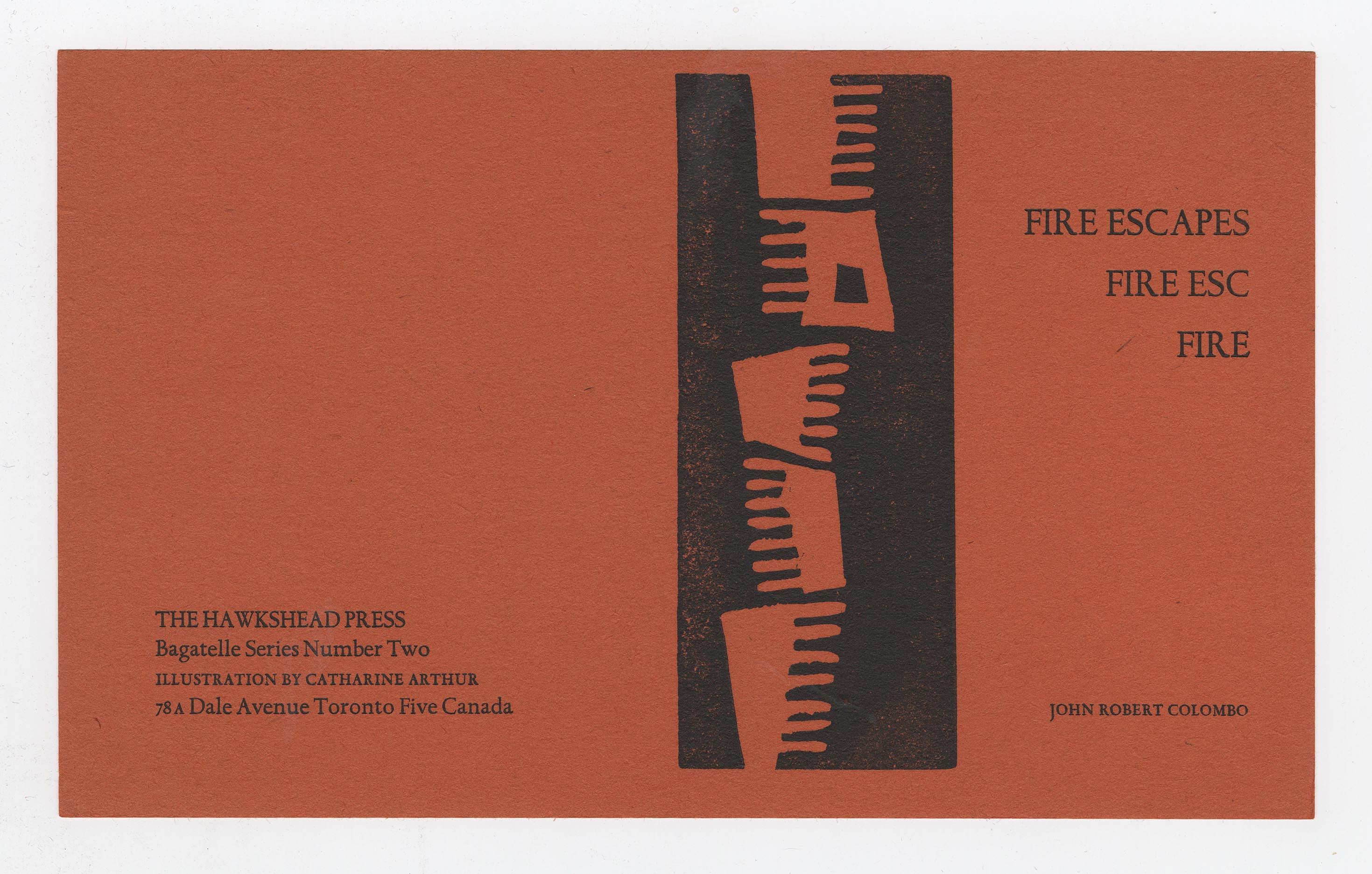CURVD H&z and Avant-Garde/Small Press Publishing in Canada
Gregory Betts, Brock University
The CURVD H&z (the form CURVD H&Z is also used) imprint series is comprised primarily of small rubber-stamped chapbooks and pamphlets that use a wide variety of binding methods. Most of the items are handmade, individual art objects; each has been catalogued and indexed, and most have  been numbered. Specific projects, like postcard poems, street posters, and the in-house little magazine, are also given their own imprint name (Sticky Lights, and Industrial Sabotage, respectively) and catalogued separately with appropriate cross-listing in other relevant series. This meticulous indexing and cataloguing demonstrates the self-consciousness of the publishing venture, and while the variety of forms and authors published by the press might seem random to a casual observer, they too are evidence of the coherence of Curry’s project. While about one-half of the publications are the result of unsolicited manuscripts, other contributors are invited to publish with his press; indeed, many CURVD H&z authors, such
been numbered. Specific projects, like postcard poems, street posters, and the in-house little magazine, are also given their own imprint name (Sticky Lights, and Industrial Sabotage, respectively) and catalogued separately with appropriate cross-listing in other relevant series. This meticulous indexing and cataloguing demonstrates the self-consciousness of the publishing venture, and while the variety of forms and authors published by the press might seem random to a casual observer, they too are evidence of the coherence of Curry’s project. While about one-half of the publications are the result of unsolicited manuscripts, other contributors are invited to publish with his press; indeed, many CURVD H&z authors, such  as bpNichol, John Riddell, Paul Dutton, Maria Erskine, David W. Harris (also known as David UU), Nelson Ball, Stuart Ross, and Gary Barwin, amongst many others, are themselves avant-garde small press publishers. Thus, the CURVD H&z backlist represents a key sampling of Canada’s activist small press publishing population.
as bpNichol, John Riddell, Paul Dutton, Maria Erskine, David W. Harris (also known as David UU), Nelson Ball, Stuart Ross, and Gary Barwin, amongst many others, are themselves avant-garde small press publishers. Thus, the CURVD H&z backlist represents a key sampling of Canada’s activist small press publishing population.
While avoiding complex theoretical debates over terminology, if we define avant-gardism simply as a concerted effort to substantially transform established art institutions, we can recognize how CURVD H&z has managed to build from both the liberating potential of small press publishing and the initial avant-gardism of bpNichol and bill bissett. Curry has developed the border-blur of form and content through numerous conceptual publishing projects. Smokes (#434), for instance, is a mystery novel by John Riddell, each chapter of which has been printed on a page that is rolled up and placed inside a handmade cigarette-style package which serves as the cover.
Such examples of conceptual publication merge perfectly with institutional criticism in curry’s 1cent series, which presents a precise critique of the dominant small press publishing models in Canada. The series is comprised of primarily handmade pamphlets  or chapbooks with one or very few poems, and through its pricing scheme presents a satiric rejection of the capitalist model for poetry publication: as the name implies, the cost is “a penny each.” Instead of attempting to create a product that generates a market that can then be capitalized upon and expanded, curry’s 1cent series works by limiting access and satirizing attempts to calculate the market value of literature. He publishes a limited number of choice works, delivered to an already interested audience, who are subsequently charged a comically small amount. The price is satirical rather than an attempt at fair valuation (in contrast, curry’s thorough bookkeeping attests to his sense of the real value of his painstakingly produced publications – but to literature, not the market).
or chapbooks with one or very few poems, and through its pricing scheme presents a satiric rejection of the capitalist model for poetry publication: as the name implies, the cost is “a penny each.” Instead of attempting to create a product that generates a market that can then be capitalized upon and expanded, curry’s 1cent series works by limiting access and satirizing attempts to calculate the market value of literature. He publishes a limited number of choice works, delivered to an already interested audience, who are subsequently charged a comically small amount. The price is satirical rather than an attempt at fair valuation (in contrast, curry’s thorough bookkeeping attests to his sense of the real value of his painstakingly produced publications – but to literature, not the market).
 Toronto publisher, poet, and bookseller Nicky Drumbolis explains the failings of current small press publishing in Canada by noting the warehouses full of unsold books that are invariably “pulped” or destroyed, or remaindered and sold for next to nothing. Government grants demand an unsustainable number of titles per publisher and too many copies printed per title, which leads to higher book costs and more overhead, which in turn contributes to the ongoing environmental disgrace of tens of thousands of unread books being destroyed every year. Furthermore, Drumbolis notes that people who support publishing in Canada are penalized for doing so when, usually a year or so later, the same books they bought at inflated prices are sold for pennies-to-the-dollar in remainder bins. Curry’s model, in contrast, limits the number of books made to sustainable quantities (increasing the object value of each), limits the number of contributions of each object made (increasing the literary and conceptual quality of each object), and limits the audience to those interested enough to order them specifically (increasing the reading value for his audience).
Toronto publisher, poet, and bookseller Nicky Drumbolis explains the failings of current small press publishing in Canada by noting the warehouses full of unsold books that are invariably “pulped” or destroyed, or remaindered and sold for next to nothing. Government grants demand an unsustainable number of titles per publisher and too many copies printed per title, which leads to higher book costs and more overhead, which in turn contributes to the ongoing environmental disgrace of tens of thousands of unread books being destroyed every year. Furthermore, Drumbolis notes that people who support publishing in Canada are penalized for doing so when, usually a year or so later, the same books they bought at inflated prices are sold for pennies-to-the-dollar in remainder bins. Curry’s model, in contrast, limits the number of books made to sustainable quantities (increasing the object value of each), limits the number of contributions of each object made (increasing the literary and conceptual quality of each object), and limits the audience to those interested enough to order them specifically (increasing the reading value for his audience). This reasonable and even environmental approach automatically disqualifies him from receiving the government support that almost all publishing ventures in Canada rely upon (including, increasingly, the small press). His holistic approach not only rejects the market-based approach to poetry publication the government demands but does so in a manner that highlights the extreme wastefulness of capitalism in general: many of curry’s publications are published on paper found in the trash bins of corporate Canada, including discarded business cards. The 21 years’ worth of material at McMaster University provides a window into the subculture of avant-garde small press publishing in Canada. Although McMaster’s collection is by no means a complete record of CURVD H&z publications, it is a testament to a set of values and an avant-garde aesthetic initiative that exists entirely outside of and against established institutional practice.
This reasonable and even environmental approach automatically disqualifies him from receiving the government support that almost all publishing ventures in Canada rely upon (including, increasingly, the small press). His holistic approach not only rejects the market-based approach to poetry publication the government demands but does so in a manner that highlights the extreme wastefulness of capitalism in general: many of curry’s publications are published on paper found in the trash bins of corporate Canada, including discarded business cards. The 21 years’ worth of material at McMaster University provides a window into the subculture of avant-garde small press publishing in Canada. Although McMaster’s collection is by no means a complete record of CURVD H&z publications, it is a testament to a set of values and an avant-garde aesthetic initiative that exists entirely outside of and against established institutional practice.
Interview with Nicky Drumbolis, October, 2008.
http://shangorama.com/messagiogalore.html
http://en.wikipedia.org/wiki/Jwcurry
http://www.ucalgary.ca/UofC/faculties/HUM/ENGL/canada/poet/j_curry.htm
Curvd H&z Press fonds, McMaster University





![Manuscript pages from "Watermarks" by Helen Humphreys, [199?]](/sites/default/files/styles/thumbnail/public/canpub/CP01117.jpg?itok=ZQdr85qB)
![Manuscript pages from "Watermarks" by Helen Humphreys, [199?]](/sites/default/files/styles/thumbnail/public/canpub/CP01117-002.jpg?itok=xTn4S8dH)

![Letter from William Kirby to J.M. LeMoine, [30 December 1885], page 3](/sites/default/files/styles/thumbnail/public/canpub/CP01119.jpg?itok=FxVd3qRd)

![William Kirby's account of meeting with Princess Louise, Government House, Ottawa, [1883]](/sites/default/files/styles/thumbnail/public/canpub/CP01121.jpg?itok=TZ3nCPyq)




